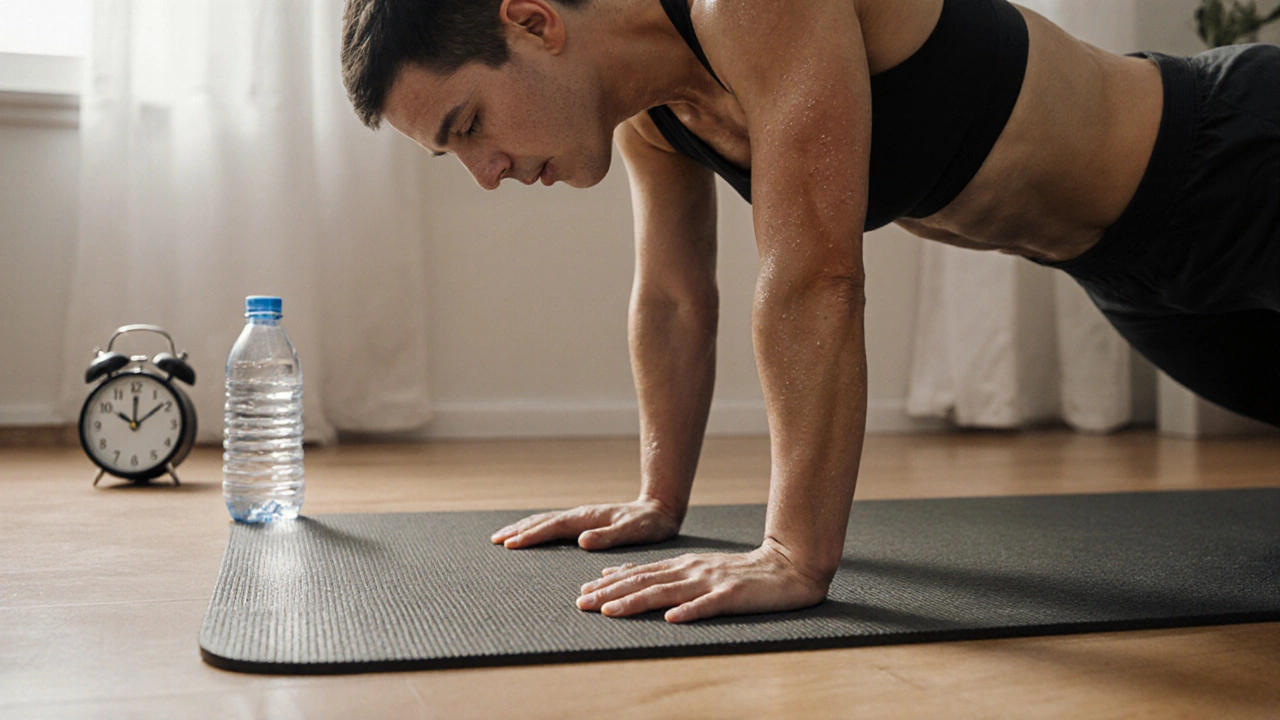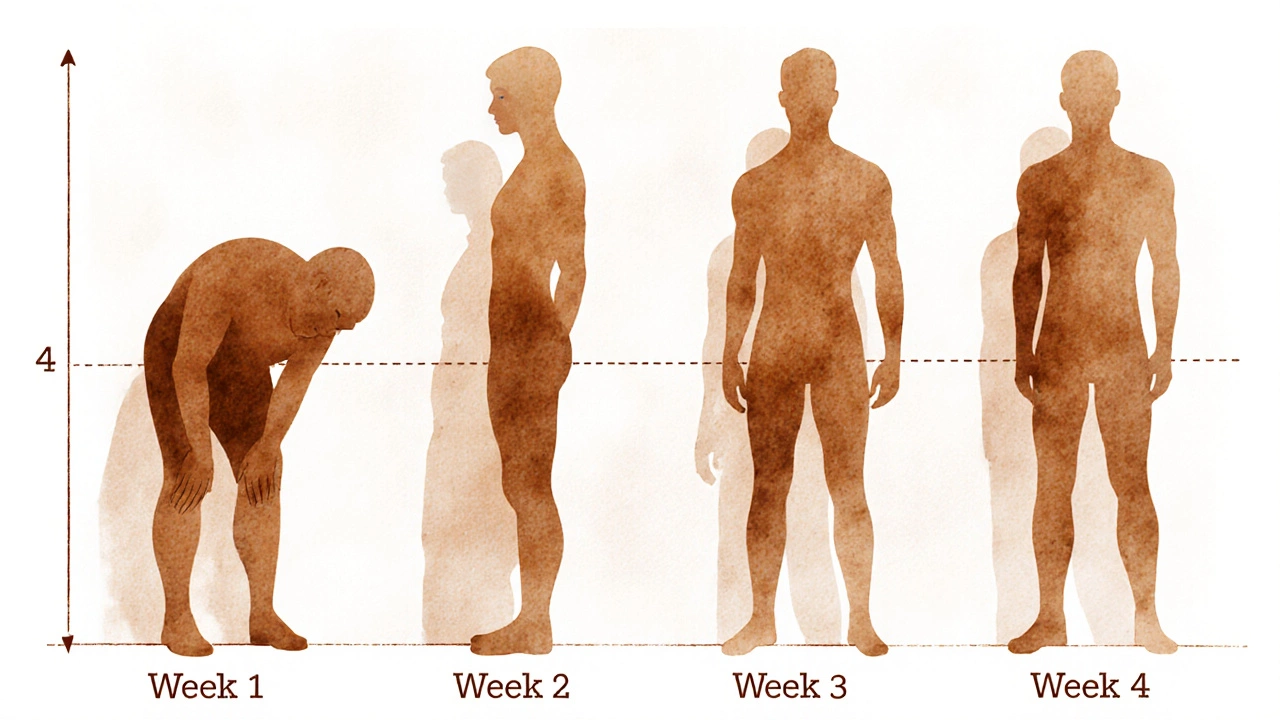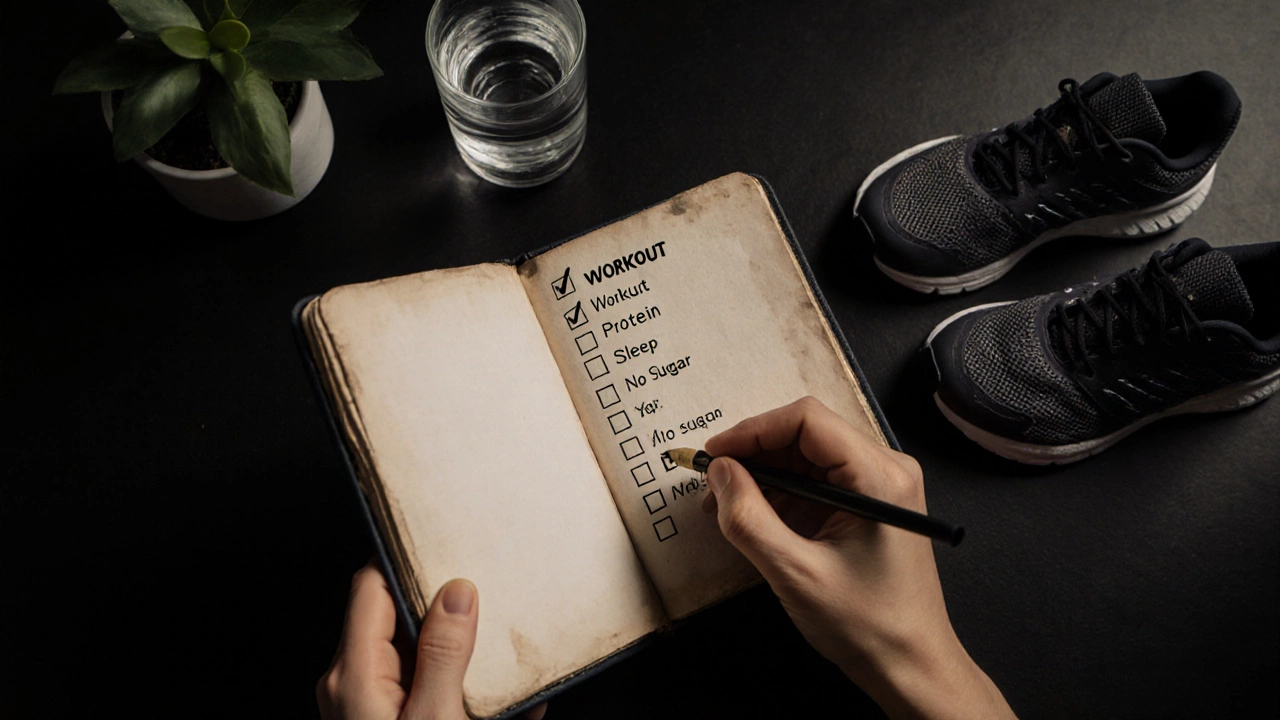Can You Transform Your Body in 30 Days? Realistic Results from Home Workouts

30-Day Body Transformation Estimator
Your Inputs
Key Insights
Realistic Expectations: Most people lose 2-5 lbs of fat and gain 1-3 lbs of muscle in 30 days with consistent home workouts.
What to Measure: Don't just track weight. Focus on how clothes fit, posture changes, and waist circumference.
Success Factors: Nutrition (especially protein intake), sleep (7-8 hours), and proper form matter more than workout duration.
Expected Results
Can you really change your body in 30 days? The answer isn’t yes or no-it’s how much and how hard. If you’re starting from zero, with little muscle tone and higher body fat, you can absolutely see visible changes in four weeks. Not a complete overhaul, but enough to notice in the mirror, feel in your clothes, and get excited about keeping going. This isn’t about becoming a bodybuilder or losing 20 pounds. It’s about building momentum with smart, consistent home workouts that fit real life.
What a 30-Day Body Transformation Actually Looks Like
Most people expect dramatic before-and-after photos-flat abs, ripped arms, waistline halved. That’s not realistic for 99% of people doing home workouts without supplements, personal trainers, or extreme diets. What you can expect: better posture, tighter skin, clothes fitting looser, more energy, and stronger muscles. You’ll lose 2-5 pounds of fat and gain 1-3 pounds of muscle if you train right. That’s not flashy, but it’s real. And it’s the foundation for long-term change.
Studies from the American Council on Exercise show that people who stick to a consistent resistance routine for four weeks gain measurable strength-up to 25% in some movements. That’s not magic. That’s biology. Your body adapts fast when you push it just enough, every day.
How to Structure Your 30-Day Home Workout Plan
You don’t need a gym. You don’t need dumbbells. You need three things: time, consistency, and movement that challenges your muscles. Here’s the simple structure that works:
- Work out 5 days a week. Rest 2 days-don’t skip rest.
- Each session: 20-30 minutes. No more, no less.
- Focus on compound movements: push-ups, squats, lunges, planks, glute bridges.
- Progress every 3-4 days: add reps, slow down the movement, or shorten rest time.
- Do cardio twice a week: brisk walking, jumping jacks, or high knees for 10-15 minutes.
Example day: 3 rounds of 12 push-ups, 15 bodyweight squats, 10 lunges (each leg), 30-second plank, 15 glute bridges. Rest 45 seconds between rounds. That’s 22 minutes. Done.
Why You Need to Focus on Form, Not Speed
Most people rush through home workouts. They do 50 sloppy push-ups because they think quantity equals results. It doesn’t. Poor form leads to injury and weak results. One perfect push-up with full range of motion-chest to floor, elbows at 45 degrees, core tight-is worth five half-reps.
Slow down. Control the descent. Squeeze your muscles at the top. Feel the burn. That’s how you recruit more muscle fibers. A 2024 study in the Journal of Strength and Conditioning Research found that people who performed resistance exercises with a 3-second eccentric (lowering) phase gained 18% more muscle mass over 30 days than those who rushed through reps.
Record yourself. Watch the video. Are your hips sagging in the plank? Are your knees caving in during squats? Fix it now. Your body will thank you in week three.

What You Eat Matters More Than You Think
You can’t out-train a bad diet. That’s not a cliché-it’s physics. If you’re eating processed snacks, sugary drinks, and oversized portions, your body won’t change no matter how many squats you do.
Here’s what to focus on for 30 days:
- Protein with every meal: eggs, chicken, tofu, Greek yogurt, lentils. Aim for 0.7-1 gram per pound of body weight.
- Vegetables with every meal: spinach, broccoli, peppers, zucchini. Fill half your plate.
- Cut out sugary drinks: soda, juice, sweetened coffee. Water is your best friend.
- Don’t starve yourself. Eat until you’re satisfied, not stuffed.
You don’t need to count calories. Just eat real food, move your body, and sleep well. That’s 80% of the battle.
The Hidden Factor: Sleep and Recovery
Most people ignore this. You don’t build muscle in the gym. You build it when you sleep. During deep sleep, your body releases growth hormone, repairs muscle tissue, and resets your metabolism. If you’re sleeping 5 hours a night and doing 30-minute workouts, you’re sabotaging yourself.
Get 7-8 hours. No exceptions. Put your phone away an hour before bed. Keep your room cool and dark. If you’re tired on day 15, it’s not because the workout was too hard-it’s because you didn’t rest enough.
One woman in a 30-day home fitness study tracked her sleep and results. She slept 6 hours a night for the first two weeks. No progress. Then she started sleeping 7.5 hours. In the last 10 days, she lost 3.2 pounds of fat and gained noticeable arm definition. Sleep wasn’t the workout. It was the secret ingredient.

What to Expect Week by Week
Week 1: You’ll feel sore. Your muscles will ache. That’s normal. You might not see changes yet, but your nervous system is learning how to fire more efficiently. That’s the first step.
Week 2: You’ll notice you can do more reps. Your breathing gets easier during squats. Your core feels tighter. Clothes feel looser around the waist. That’s fat loss and muscle activation kicking in.
Week 3: You’ll catch yourself standing taller. Your shoulders aren’t hunched. You feel stronger lifting groceries or carrying bags upstairs. That’s posture change. That’s real.
Week 4: You’ll look in the mirror and say, “Huh. I actually look different.” You’ll feel more confident. You’ll want to keep going. That’s the transformation.
Common Mistakes That Kill Results
Here’s what stops people before week three:
- Skipping rest days-burnout sets in fast.
- Doing the same workout every day-your body adapts and stops changing.
- Chasing the scale-weight doesn’t tell the full story. Measure waist, hips, and how clothes fit.
- Comparing yourself to influencers-those are months or years of work, often with lighting and editing.
- Giving up after a missed day-life happens. Just get back on track the next day.
The most successful people aren’t the ones who never miss. They’re the ones who show up again after missing.
What Comes After 30 Days?
Don’t stop. That’s the biggest mistake. The 30-day challenge isn’t the finish line. It’s the launchpad. Now you know you can do this. Now you know how your body responds. Keep going. Add light dumbbells. Try a 40-minute workout. Add one more day of movement. Build a habit.
After 30 days, you won’t be a different person. You’ll be the same person-just stronger, leaner, and more confident. And that’s enough to keep going for the next 30 days. And the next.
Can you lose belly fat in 30 days with home workouts?
You can’t spot-reduce fat. But you can lose overall body fat-which includes belly fat-by combining consistent home workouts with better nutrition. Focus on full-body strength training and cutting sugar. Most people lose 1-3 inches from their waist in 30 days if they stick to both.
Do I need equipment for a 30-day body transformation?
No. Bodyweight exercises like push-ups, squats, and planks are powerful enough to transform your body in 30 days. If you want to increase difficulty later, a pair of dumbbells or resistance bands help-but they’re not required to start.
How many calories do home workouts burn in 30 minutes?
It depends on your weight and intensity. A 150-pound person doing moderate-intensity bodyweight circuits burns about 150-200 calories in 30 minutes. Add jumping movements or faster pacing, and you can hit 250-300. The real benefit isn’t just calories burned-it’s the muscle gain that boosts your resting metabolism.
Is it safe to do home workouts every day?
No. Muscles grow when they rest. Doing intense workouts every day leads to overtraining, fatigue, and injury. Stick to 5 days of strength training and 2 rest or light activity days. Walking or stretching on rest days is fine.
What if I don’t see results after 30 days?
If you followed the plan and saw no change, check your diet and sleep. Most people underestimate how much they eat or overestimate how hard they worked. Take progress photos, measure your waist, and track how your clothes fit. If those haven’t changed, you likely need to eat less sugar and get more sleep-not do more workouts.